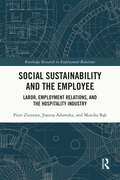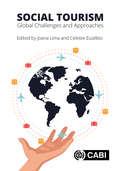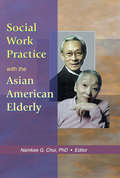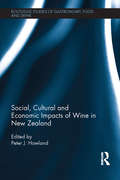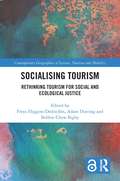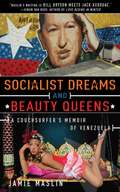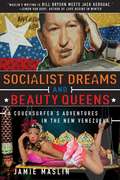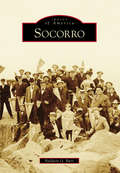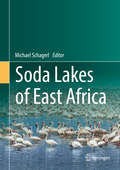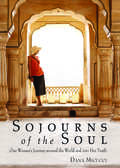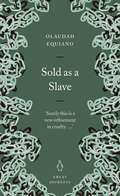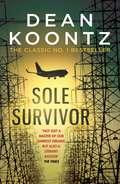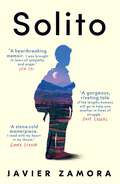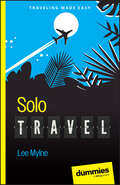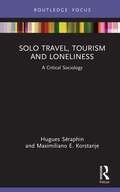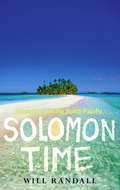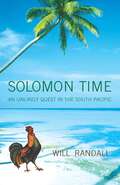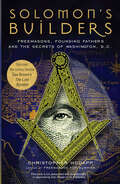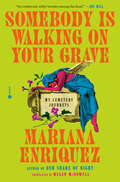- Table View
- List View
Social Sustainability and the Employee: Labor, Employment Relations, and the Hospitality Industry (Routledge Research in Employment Relations)
by Piotr Zientara Joanna Adamska Monika BąkThis research monograph delves into the pressing issue of employee-centered social sustainability in the hospitality industry. Through empirical studies and content analysis of CSR reports, it highlights the significant challenges faced by frontline hospitality workers – such as low wages, job insecurity, limited union representation, and employer resistance to unionization.Offering a thorough, evidence-based examination, the monograph provides a comprehensive analysis of the employee dimension of social sustainability. It explores the critical role of organizational support, the fear of unionizing, and their impact on key outcomes like employee well-being and industry turnover intentions. The work also proposes a tailored framework for addressing employee needs at different stages of their careers, advancing the goal of "decent work" within the industry.Ideal for scholars and researchers in workforce studies, hospitality, and tourism, this volume offers valuable insights into the complex dynamics of labor practices and social sustainability. It serves as a vital resource for those seeking to foster employee-centered CSR initiatives. Policymakers, industry professionals, and advocates for improved labor conditions in hospitality will also find this book informative and thought-provoking, with actionable strategies for promoting social responsibility across the sector.
Social Tourism in Europe
by Lynn Minneart Scott MccabeThis book, the first on social tourism in English, provides a comprehensive analysis of the various systems and practices in support of disadvantaged people's enjoyment of tourism. Combining theory and practice and a truly European perspective, this book provides an interdisciplinary approach to examine the concepts and contexts underpinning social tourism that will be a key reference point for students, practitioners and researchers. Theoretical perspectives on social tourism are assessed in the context of social inequality, sustainability, family diversity, mobility and the welfare society. The case studies cover public initiatives, charities and voluntary organisations, from a range of different countries including the UK, Ireland, Belgium, Denmark and Poland, covering the diversity of systems and practices in Europe.
Social Tourism: Global Challenges and Approaches
by Anya Diekmann Lynn Minnaert Neil Carr Elisabete Figueiredo Scott McCabe Dr Maria João Carneiro Raija Komppula Elisa Alén González Zorana Medaric Helena Alvelos Trinidad Domínguez Vila Adriana E. Estrada-González Celeste Eusébio Janja Gabruc Konstantinos I Kakoudakis Elisabeth Kastenholz Nieves Losada Sánchez Cátia Loureiro Michel Xavier Katerina Papadoulaki Mariana Pedrosa Rutherford Gill Fathimath Shiraani Elli VentoSocial tourism - the practice of offering programmes, events and activities to enable disadvantaged population groups to enjoy tourism - is of increasing interest to academia. Beginning with an introduction to the social tourism concept, its relevance and target groups, this book then provides reflections about emerging topics case studies of programmes in action across Europe, Oceania and the Americas. It considers the tourism experience from the point of view of young people, families, senior citizens and people with disabilities, before covering the impacts of social tourism initiatives on both participants and tourism destinations. It concludes by reflecting on the practical challenges and policy implications emerging from theory and practice, highlighting common challenges and identifying guidelines for designing social tourism initiatives. This book: Covers the challenges faced by the sector and the relevance of promoting tourism programmes for disadvantaged groups of society. Promotes research that bridges theory and practice, permitting the identification of guidelines for more effective social tourism initiatives. Includes case studies from around the world to provide a global perspective. An important read for researchers of tourism, social inclusion and accessibility, this book will therefore also be of interest to students and practitioners of these areas.
Social Work Practice with the Asian American Elderly
by Namkee G ChoiThis fascinating book addresses the cultures and concerns of five major ethnic groups: Chinese, Japanese, Korean, Asian Indian, and Vietnamese. Social Work Practice with the Asian-American Elderly examines the diverse needs of this rapidly growing population. It suggests interventions and service-delivery models that are culturally sensitive and appropriate for these clients, many of whom are first-generation immigrants still closely linked with their cultures of origin. This comprehensive book serves as a timely resource for both researchers and practitioners concerned with this neglected yet rapidly growing segment of the elderly population. Social Work Practice with the Asian-American Elderly offers both quantitative and qualitative research on essential topics, including: migratory grief assimilation depression elderly nutrition programs social support
Social, Cultural and Economic Impacts of Wine in New Zealand. (Routledge Studies of Gastronomy, Food and Drink)
by Peter J. HowlandNew Zealand’s wine came to the world’s attention in the late 1980’s with its production of some of the best quality sauvignon blancs. Since then the industry has grown significantly and has increasingly gained an international reputation as a producer of quality, boutique wines.This volume provides an innovative, multi-disciplinary and critical review of wine production and consumption focusing specifically on the fascinating wine industry of New Zealand. It considers the history, production, aesthetics, consumption and role of place (identity) from multi-disciplinary perspectives to offer insight into the impacts of wine production and consumption. By linking the study of wine to broadly constructed social, cultural, historical and transnational processes the book contributes to contemporary debates on the “life of commodities”, “social class” and “place and people”. Throughout comparisons are made to other internationally recognized wine regions such as Bordeaux and Burgundy.This title furthers the understanding of the social/cultural context of wine production and consumption in this region and will be valuable reading to students, researchers and academics interested in gastronomy, wine studies, tourism and hospitality.
Socialising Tourism: Rethinking Tourism for Social and Ecological Justice (Contemporary Geographies of Leisure, Tourism and Mobility)
by Freya Higgins-Desbiolles Adam Doering Bobbie Chew BigbyOnce touted as the world’s largest industry and also a tool for fostering peace and global understanding, tourism has certainly been a major force shaping our world. The recent COVID-19 crisis has led to calls to transform tourism and reset it along more ethical and sustainable lines. It was in this context that calls to "socialise tourism" emerged (Higgins-Desbiolles, 2020). This edited volume builds on this work by employing the term Socialising Tourism as a broad conceptual focal point and guiding term for industry, activists and academics to rethink tourism for social and ecological justice. Socialising Tourism means reorienting travel and tourism based on the rights, interests, and safeguarding of traditional ecological and cultural knowledges of local peoples, communities and living landscapes. This means making tourism work for the public good and taking seriously the idea of putting the social and ecological before profit and growth as the world re-emerges from the COVID-19 pandemic. This is an essential first step for tourism to be made accountable to the limits of the planet. Concepts discussed include Indigenous culture, toxic tourism, a "theory of care", dismantling whiteness, decolonial tourism and animal oppression, among others, all in the context of a post-COVID-19 world. This will be essential reading for all upper-level students, academics and policymakers in the field of tourism.
Socialist Dreams and Beauty Queens: A Couchsurfer's Memoir of Venezuela
by Jamie MaslinCouchsurfer, hitchhiker, and rogue wanderer Jamie Maslin embarks on a couchsurfing adventure to the homeland of "firebrand," "populist," "anti-American" president Hugo Chavez: the Bolivarian Republic of Venezuela. Alone in the crime capital of the world Maslin immediately finds himself in trouble-arrested by knife-wielding police officers and inoculated with an unwanted vaccination. After a terrifying start in Caracas, he soon leaves the teeming city and travels to the places tourists never see, staying on the couches of people he befriended online just days earlier, and meeting everyone from fervent social revolutionaries to the country's wealthy elite. He sets off in search of mile-high waterfalls, flat topped jungle plateaus, rolling deserts, and the famous lightning that appears suddenly in the sky with no rain or thunder. Visiting sprawling slums and opulent mansions, Maslin offers a fascinating and timely social, cultural, and histori- cal introduction to a country increasingly in the headlines. Often irreverent, frequently informative, and habitually funny, this is the remarkable account of a young adventurer's journey through a breathtakingly beautiful and dynamic country where the politics of oil and social revolution are never far from the surface. 24 full-color photographs
Socialist Dreams and Beauty Queens: A Couchsurfer?s Adventures in the New Venezuela
by Jamie MaslinCouchsurfer, hitchhiker, and rogue wanderer Jamie Maslin embarks on a couchsurfing adventure to the homeland of "firebrand,” "populist,” "anti-American” president Hugo Chavez: the Bolivarian Republic of Venezuela. Alone in the crime capital of the world Maslin immediately finds himself in trouble-arrested by knife-wielding police officers and inoculated with an unwanted vaccination. After a terrifying start in Caracas, he soon leaves the teeming city and travels to the places tourists never see, staying on the couches of people he befriended online just days earlier, and meeting everyone from fervent social revolutionaries to the country’s wealthy elite. He sets off in search of mile-high waterfalls, flat topped jungle plateaus, rolling deserts, and the famous lightning that appears suddenly in the sky with no rain or thunder. Visiting sprawling slums and opulent mansions, Maslin offers a fascinating and timely social, cultural, and historical introduction to a country increasingly in the headlines.Often irreverent, frequently informative, and habitually funny, this is the remarkable account of a young adventurer’s journey through a breathtakingly beautiful and dynamic country where the politics of oil and social revolution are never far from the surface.
Sociopragmatics of Japanese: Theoretical Implications (Routledge Research in Pragmatics)
by Michael Haugh Yasuko ObanaObana and Haugh question the extent to which commonly accepted theories in pragmatics can readily explain sociopragmatic phenomena in Japanese. Studies of Japanese in pragmatics have often challenged the cross-linguistic relevance of dominant theories. However, they have also inadvertently perpetuated stereotypes about the Japanese. It is often been assumed, for instance, that Japanese people are less strategic, more polite and more reliant on tacit forms of communication than speakers of other languages. But the Japanese are not as polite as one might think. The aim of this book is thus to question those folk assumptions around politeness, impoliteness, irony and indirectness while at the same time emphasizing that close examination of sociopragmatic phenomena in Japanese yields important empirical insights that combat common theoretical assumptions in pragmatics. The content is structured in three parts, in which the authors highlight a key building block of a theory of sociopragmatics. Part I focuses on indexing through the lens of chapters on honorifics, routine formula and politeness strategies. Part II focuses on evaluating through the lens of chapters on giving/receiving expressions and honorific irony. Finally, Part III focuses on relating through the lens of chapters on joint utterances and off record requests. Throughout the chapters the authors draw attention to ways in which these three dimensions are invariably intertwined in various ways. This book is not simply a collection of studies that promotes our understanding of the sociopragmatics of a particular language, but goes deeper and challenges what many have taken for granted in pragmatics. It proposes a framework for exploring sociopragmatic phenomena, building on the key sociopragmatic axes of indexing, evaluating and relating, and offers fresh new perspectives on time-honoured phenomena in pragmatics. It will interest scholars and postgraduate students in pragmatics, particularly those specializing in: politeness, impoliteness, indirectness and irony. The book explains what Japanese terms mean, and all the Japanese examples are morphologically-glossed. Therefore, teachers (and advanced learners) of Japanese at all levels will benefit from the book as it will enrich their knowledge of the Japanese language.
Socorro
by Baldwin G. BurrThe town of Socorro got its name from the "succor" travelers found at the northern end of a 90-mile-long desert trail known as the Jornada del Muerto, the "Journey of the Dead Man," in central New Mexico. The village of Socorro, located at the site of the ancient 1600s Piro Pueblo, was first settled sometime around 1816 as an agricultural community. The discovery of silver at Socorro Peak and the Magdalena Mountains and the arrival of the railroad in 1880 brought boom times to the town. The demonetization of silver in 1893 was the end of Socorro's boom, and the community gradually reverted to its agricultural heritage. Reminders of days gone by can still be seen in Socorro. The Garcia Opera House, the Crown Mill, the Illinois Brewery, and several historic houses have been successfully preserved.
Soda Lakes of East Africa
by Michael SchagerlThis book is devoted to the alkaline-salinelakes of East Africa, which include the world-famous "flamingo lakes". Itcovers the full range of issues, from the lakes' origin and history, life inand around these unique water bodies, to utilization, threats and managementconsiderations. The authors, all of whom are leading international experts,summarize research done so far, highlight new and important findings, andprovide future outlooks. The book is divided into three main sections:"Genesis, physics and chemistry" tackles lake development and the astoundingphysico-chemistry of the lakes. "Organisms and ecology" presents informationabout the many lake inhabitants, their interactions and adaptations to theextreme living conditions. "Utilization, management and perspectives" addressesthreats such as lake exploitation and pollution, but also considers potentialuses. This book will be particularly relevant to researchers and lecturers inthe field of limnology and aquatic ecology, but is also designed to attract allthose interested in nature and life on our planet.
Sojourns of the Soul
by Dana MicucciSojourns of the Soul differs from other inspirational travel books by providing a rare mix of in-depth wisdom and literary insights from the holistic view of one experienced female traveler. Dana Micucci gives a compelling account of her growing spiritual illumination through visits to some of the most sacred places on earth. Her lively, engaging narrative takes us to seven sites in all: the Australian outback, Angkor in Cambodia, the Valley of the Kings in Egypt, Lhasa in Tibet, Chichen Itza in the Yucatan; the Monastery of Christ in the Desert in New Mexico, and Machu Picchu in Peru.Micucci links each visit with the awakening of a particular chakra- the chakras being the seven energy centers of the body associated in Hinduism with progressive enlightenment. In the afterword, she reflects on how her experiences continue to shape her life after resuming her career as a journalist in New York City: she finds she is more tolerant, can engage in daily activities with more heart-centered awareness, and can sustain states of joy and gratitude for longer periods of time.The book will be a page turner for readers who yearn for long-delayed adventure, with the added benefit that it is not just a journey log but more of a seeker's manual; travel is simply the vehicle. Readers will find that they don't have to travel to far-flung places for the spiritual inspiration available in their everyday lives. As Micucci says, "Each day brings new remembrances of our divinity, of the Divine presence in all beings, and of our eternal connection to each other. I am so grateful to be here NOW . . . with you."
Solace
by Mary SojournerNPR commentator Mary Sojourner, "a pithy yet sensuous, spiritual yet ferocious writer" (Booklist), delivers a powerful memoir about the joys of rejecting the pace, addictions, and false values of society...and learning to live without compromise. Twenty years ago, Mary Sojourner was a mental health consultant and counselor in Rochester, New York, a divorced mother of three, longing for her real work, her real home. She found it in Flagstaff, Arizona, in a remote two-room cabin that had no running water and only a wood stove for heat, but offered Sojourner everything she needed in terms of light, beauty, joy, and the perfect setting for writing and reconnecting. Solace is a book about obsession and release, and the lifelong search for balance in a world revolving around appetite and acceleration. Written in short, beautifully crafted pieces, the book carries the reader through Sojourner's life, from a restrained Catholic childhood to the excesses of her generation, through motherhood and divorce to her quiet, solitary existence in the Southwest, where she has learned the importance of living at the right pace. Sojourner's voice is as compelling on the page as it is on the radio -- lively, funny, moving, combining the outspoken out-of-stepness of Anne Lamott with the environmental activism and poetic prose of Terry Tempest Williams. In chapters with titles such as "God Is Coming and She Is Pissed" and "How to Leave: Leave," her vivid personality, passion, and sense of humor come through. This is a book for women everywhere -- those who recognize their own truths in Mary's life and younger readers who will find inspiration in her hard-won wisdom.
Sold as a Slave (Great Journeys Ser. #No. 8)
by Olaudah EquianoIn an adventurous and extraordinary life, Equiano (c.1745-c.1797) criss-crossed the Atlantic world, from West Africa to the Caribbean to the USA to Britain, either as a slave or fighting with the Royal Navy. His account of his life is not only one of the great documents of the abolition movement, but also a startling, moving story of danger and betrayal.Great Journeys allows readers to travel both around the planet and back through the centuries – but also back into ideas and worlds frightening, ruthless and cruel in different ways from our own. Few reading experiences can begin to match that of engaging with writers who saw astounding things: Great civilisations, walls of ice, violent and implacable jungles, deserts and mountains, multitudes of birds and flowers new to science. Reading these books is to see the world afresh, to rediscover a time when many cultures were quite strange to each other, where legends and stories were treated as facts and in which so much was still to be discovered.
Sole Survivor: A gripping, heart-pounding thriller from the number one bestselling author
by Dean Koontz300 died in a mysterious plane crash...but really happened? From bestselling phenomenon Dean Koontz, this gripping thriller is perfect for fans of THE EYES OF DARKNESS and Stephen King.'Dean Koontz is not just a master of our darkest dreams, but also a literary juggler' The TimesA catastrophic, unexplained plane crash leaves three hundred and thirty dead - and no survivors.Among the victims are the wife and two daughters of Joe Carpenter, a Los Angeles Post crime reporter.A year after the crash, still gripped by an almost paralysing grief, Joe encounters a woman who claims to have survived the crash. But before he can ask any questions, she slips away.As desperate chase and shattering emotional odyssey will lead Joe to a truth that will force him to reassess everything he thought he knew about life and death - a truth that, given the chance, will rock the world and redefine the destiny of humanity.What readers are saying about Sole Survivor:'The action is fast paced, the characters are well developed and the suspense is excellent - I certainly would not have guessed the ending''This book takes off at breakneck speed. It will keep you glued to the edge of your seat''This is one of the only books ever to keep me guessing right to the end. The end is absolutely brilliant!'
Solito: A Memoir
by Javier Zamora'Heartbreaking… A rare, eye-opening rendition of the brutal reality of border-crossing.' Lea Ypi &‘If there&’s any justice, Solito will someday be considered a classic.&’ Rumaan Alam Young Javier dreams of eating orange sherbet ice cream with his parents in the United States. For this to happen, he must embark on a three-thousand-mile journey alone. It should last only two weeks. But it takes seven. In limbo, Javier learns what people will do to survive – and what they will forfeit to save someone else. This is a memoir of perilous boat trips, relentless desert treks, and pointed guns. But it is also a story of tasting tacos for the first time, of who passes you their water jug in the crippling heat, and of longing to be in your mother&’s arms.
Solo Travel For Dummies
by Lee MylneA friendly resource to help you prepare for exciting domestic or international travel—on your own Solo Travel For Dummies teaches you how to plan the solo trip of a lifetime with must-know info, insider tricks, safety essentials, and more. Whether you’re a seasoned jetsetter or nervous first timer, you’ll learn everything you need to know. Choose your destination, plan a fulfilling itinerary, save money, and stay safe, no matter where in the world you may roam. As a solo traveler, you’ll appreciate this book’s specific tips on how to avoid loneliness, what to do if you get lost, and how to plan ahead so you can enjoy your trip. Tuck this portable Dummies travel guide into your backpack or suitcase, and you’ll be ready for your once-in-a-lifetime adventure. Find expert travel tips for minimizing stress and maximizing enjoyment Learn how to plan the perfect solo itinerary for your goals Discover unique destinations and can't-miss cultural experiences Get expert tips on safety, budgeting, and so much more!Solo Travel For Dummies is for anyone who needs a trusted, comprehensive source of information as they prepare to travel independently.
Solo Travel, Tourism and Loneliness: A Critical Sociology (Routledge Focus on Tourism and Hospitality)
by Maximiliano E. Korstanje Hugues SéraphinThis timely and topical book presents a unique critical exploration of the sociology of single travel and theory of consumption in relation to loneliness and tourism.Logically structured and interdisciplinary in scope, this book introduces disrupting questions around the convergence of the post-modern self in relation to solo travel post-pandemic, with chapters exploring topics such as romantic loneliness, the benefits and drawbacks of single travel in a globalized world, the influence of technology on solo travel and the impact of sex tourism. International case studies and examples are given throughout and the book is richly illustrated and data-led. The volume looks to the future, exploring relevant trends and the development of new products and services in the next few years.This volume is a pivotal resource for students, scholars and academics with an interest in tourism and mobility studies, international relations, development economics, crisis management, sociology and public policy. The book may also be of professional interest to practitioners and policymakers dedicated to tourism sociology and sociology of tourism consumption.
Solomon Time: Adventures in the South Pacific
by Will RandallEchoing the experiences of Robert Louis Stevenson - who spent several years in the South Pacific - here is the story of a contemporary writer who lived in and came to love the Solomon Islands. Most unexpectedly, Will Randall, once a happy schoolteacher, found himself dispatched to a small village on a not very large island, far out in the vastness of the South Pacific. His mission (although he had hardly chosen to accept it): - to fulfil the dying wishes of the 'Commander' and help the local people set up a money-making community project. The Solomon Islands, islands lost in time - Solomon Time; these little gems of land scattered across the ocean, must be the last sanctuary on our shrivelled planet not yet overshadowed by the Golden Arches or encapsulated in a Coca-Cola bubble. Everyone has dreamed at some time of living on a desert island. Here is the unvarnished truth. Sharks, turtles, a band of unruly chickens, a cast of extraordinary characters, and a bird called the Spangled Drongo, accompany Will Randall through some of the most fascinating and certainly funniest scenes to be found in travel writing since Gerald Durrell.
Solomon Time: Adventures in the South Pacific
by Will RandallEchoing the experiences of Robert Louis Stevenson - who spent several years in the South Pacific - here is the story of a contemporary writer who lived in and came to love the Solomon Islands. Most unexpectedly, Will Randall, once a happy schoolteacher, found himself dispatched to a small village on a not very large island, far out in the vastness of the South Pacific. His mission (although he had hardly chosen to accept it): - to fulfil the dying wishes of the 'Commander' and help the local people set up a money-making community project. The Solomon Islands, islands lost in time - Solomon Time; these little gems of land scattered across the ocean, must be the last sanctuary on our shrivelled planet not yet overshadowed by the Golden Arches or encapsulated in a Coca-Cola bubble. Everyone has dreamed at some time of living on a desert island. Here is the unvarnished truth. Sharks, turtles, a band of unruly chickens, a cast of extraordinary characters, and a bird called the Spangled Drongo, accompany Will Randall through some of the most fascinating and certainly funniest scenes to be found in travel writing since Gerald Durrell.
Solomon Time: An Unlikely Quest in the South Pacific
by Will RandallWho hasn't fantasized about dismantling his or her hassled, wired-up life for a simpler existence? Yet who among us has the will and opportunity to do it? The answer, of course, is very few.Will Randall, a young English schoolmaster, had such a chance -- and took it. He uprooted his conventional First World life and let himself be blown to one of the farthest and most beautiful corners of the earth, the Solomon Islands of the South Pacific. In the entertaining tradition of Bill Bryson's In a Sunburned Country, this is the story of Solomon Time.From the first, it's an improbable journey. In a chance encounter on a rugby field, Randall meets a doddering old man known as "the Commander," who has retired to England after running a cocoa plantation in the South Pacific for thirty years. Six months later, the Commander dies and his will is read: he wants someone to travel to his beloved, long-missed island -- where his plantation has fallen into ruin -- and devise a way for the natives to support themselves. If successful, they might avoid poverty, build a new school, and even fend off the greedy developers circling their peaceful waters.It's a mission of noblesse oblige, yet possibly a fool's errand, too. Randall agrees to go.Spread across the Tropic of Capricorn, the Solomon Islands are not so much the Pacific archipelago that time forgot as the one that forgets time. Randall's new home is Mendali, a fishing village so remote it can be reached only by motorized canoe. But the people of the village, some with cheeks engraved with a rising sun, are welcoming, for they remember the Commander kindly, and still practice a pagan Anglicanism in a church he built for them in 1956. They sleep in houses made of leaves and live on fish of every sort, mud crabs, yams, ngali nuts, even the honeycomb of termites.Randall decides that the villagers could raise chickens, and they greet the idea with enthusiasm. But finding live chicken eggs in their watery world proves wildly difficult, and Randall must chase after the eggs over shark-infested seas and through jungles where strange characters reside, including a one-eyed dwarf and a tattooed lady.One couldn't imagine a better man than Will Randall to help the people of Mendali meet the twenty-first century on their own terms. But will he succeed?Solomon Time is a moving and witty account of one man's accidental adventure in paradise and is certain to enchant explorers and armchair travelers alike.
Solomon's Builders: Freemasons, Founding Fathers and the Secrets of Washington D.C. (Reference Ser.)
by Christopher I HodappUnearth the fascinating history of how the Freemasons and Founding Fathers sowed the seeds of a new nation amid the collapse of the British colonies.Step back in time to the birth of a revolutionary new republic and discover how the utopian ideals of a visionary secret society laid the foundation for the most powerful nation on earth. Follow George Washington, Benjamin Franklin and other Founding Fathers as they transform the democratic principles of their Masonic lodges into a radical new nation.Solomon’s Builders unravels history from myth as it takes you on a Freemason’s tour of Washington, D.C. It reveals the evidence of Masonic influence during the construction of America and its new capital, including clues hidden in plain sight:•Masonic connections to national monuments•Puzzling pentagrams and symbolism in city streets•The mysterious temples of the “Widow’s Sons”Solomon’s Builders relates the true stories of these visionary founders, and the fascinating meaning behind the cryptic codes, enigmatic symbols and intriguing architecture that is reputedly the basis for the sequel to The Da Vinci Code, Dan Brown’s novel The Lost Symbol.“Well written account of the philosophical thinking that led to the formation of a common man’s democracy. . . . The reference book that teachers need to use in their American History classes.” —Karl Grube, Ph.D., Bonisteel Masonic Library, Ann Arbor, MI“One of the better books that I have seen that credits Freemasonry where credit is due.” —Thomas W. Jackson, The Northern Light Magazine“What distinguishes Solomon’s Builders from the good and bad, malicious and benevolent, is its honesty, humor and clarity.” —Mark A. Tabbert, author of American Freemasons“An academically written book on the early days of American Freemasonry without the pretentious trappings of most scholarly treatments on the subject.” —Stephen Dafoe, author of Nobly Born
Some Like It Hot!: Yellowstone's Geysers and Hot Springs
by Susan M. NeiderSome Like It Hot! is a beautiful visual portrait of Yellowstone National Park's best and most favorite thermal features. This stunning portfolio of photographs by Susan M Neider is uniquely organized by geographic region, so it's easy to find specific geysers, hot springs, mud pots, and fumaroles. Fascinating historical descriptions by early explorers of the geyser basins--including General H.D. Washburn, F.V. Hayden, and famed conservationist John Muir--accompany these vibrant images and emphasize the timeless beauty and wonder of Yellowstone.
Somebody Is Walking on Your Grave: My Cemetery Journeys
by Mariana EnriquezAn enchanting, highly personal tour of some of the most iconic cemeteries of the world—part travelogue, part memoir, part &“excursions through death,&” by the author of Our Share of Night and &“queen of horror&” (Los Angeles Times)&“Not a travelogue so much as a grave-a-logue, Somebody is Walking on Your Grave is an exuberant, witty wander among the dead. You could not have a better friend to take you by the hand and lead you for a long traipse among tilting tombstones, dank crypts, and chilling history.&”—Joe Hill&“Enriquez knows cemeteries are the repositories of life&’s pain and beauty. I felt more alive as I read.&”—Caitlin Doughty, New York Times bestselling author of Smoke Gets in Your Eyes: And Other Lessons from the Crematory&“An eccentric and enlightening peek into how memorialization happens across the world.&”—Publishers Weekly, starred review&“Fascinating . . . Enriquez hides a celebration of life in a book about death.&”—Booklist, starred reviewOne of Publishers Weekly&’s Top 10 New Releases of the Fall • A Most Anticipated Book of the Fall: Chicago Tribune, Los Angeles Times, Literary Hub, Ms. Magazine, Bustle, Book Riot, Publishers LunchCemeteries have great stories and sometimes I steal some for my books.Mariana Enriquez—called by The New York Times a &“sorceress of horror&”—has been fascinated by the haunting beauty of cemeteries since she was a teenager. She has visited them frequently, a goth flaneur taking notes on her aesthetic obsession as she walks among the headstones, &“where dying seems much more interesting than being alive.&”But when the body of a friend&’s mother who was disappeared during Argentina&’s military dictatorship was found in a common grave, Enriquez began to examine more deeply the complex meanings of cemeteries and where our bodies come to rest.In this rich book of essays—&“excursions through death,&” she calls them—Enriquez travels through North and South America, Europe and Australia, visiting Paris&’s catacombs, Prague&’s Old Jewish Cemetery, New Orleans&’s aboveground mausoleums, Buenos Aires&’s opulent Recoleta, and more. Enriquez investigates each cemetery&’s history and architecture, its saints and ghosts, its caretakers and visitors, and, of course, its dead.Weaving personal stories with reportage, interviews, myths, hauntology, and more, Somebody Is Walking on Your Grave is memoir channeled through Enriquez&’s passion for cemeteries, revealing as much about her own life and unique sensibility as the graveyards and tombstones she tours. Fascinating, spooky, and unlike anything else, Enriquez&’s first work of nonfiction, translated by the award-winning Megan McDowell, is as original and memorable as the stories and novels for which she&’s become so beloved and admired.
Someday We'll Tell Each Other Everything
by Daniela KrienIt is summer 1990, only months after the border dividing Germany has dissolved. Maria, nearly seventeen, moves in with her boyfriend on his family farm. A chance encounter with enigmatic loner Henner, a neighbouring farmer, quickly develops into a passionate relationship. But Maria soon finds that Henner can be as brutal as he is tender - his love reveals itself through both animal violence and unexpected sensitivity. Maria builds a fantasy of their future life together, but her expectations differ dramatically from those of Henner himself, until it seems their story can only end in tragedy. Someday We'll Tell Each Other Everything is a bold and impressive debut in which love and violence, conflict and longing, are inextricably entwined.
